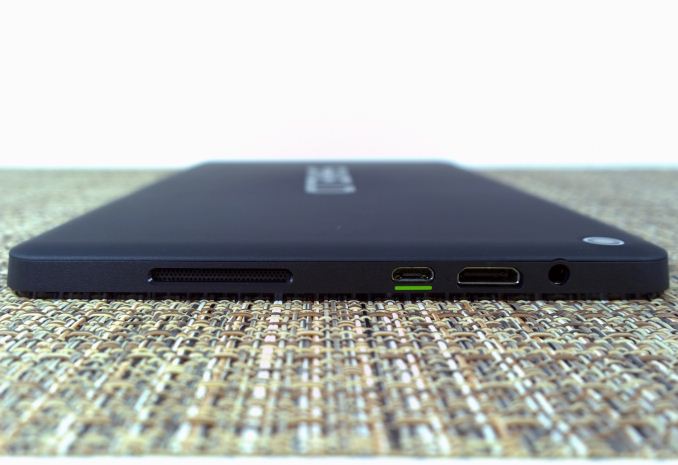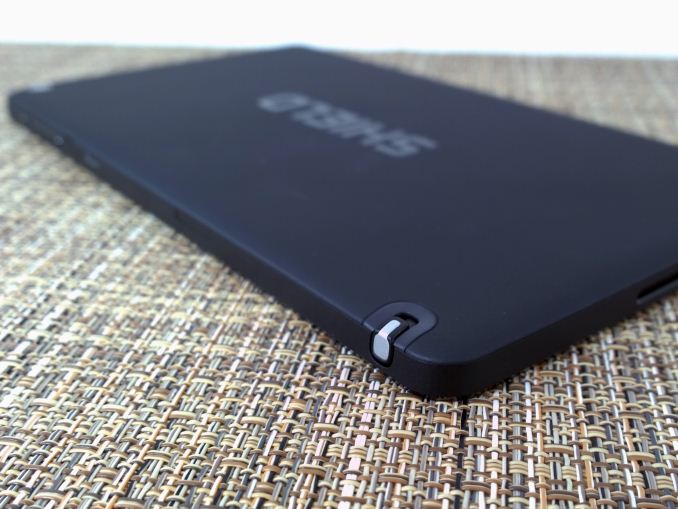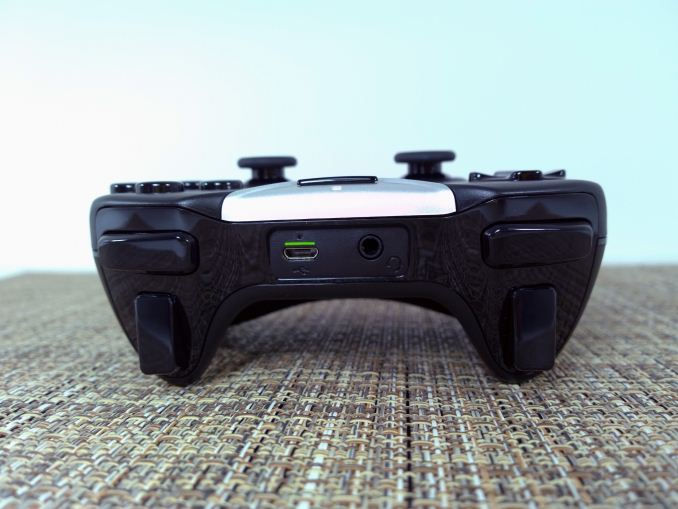The NVIDIA SHIELD Tablet Review
by Joshua Ho on July 29, 2014 9:00 AM ESTFinal Words
If I’m honest, it’s hard for me to review tablets. While I academically understand why people like tablets, I’ve never really found a use for them. They’re less comfortable to use in bed than a phone, I usually can’t type on a tablet as quickly as I do on a phone due to the size and weight, and in general it’s hard to justify a tablet when a phone is generally much more versatile. So when I got the Shield Tablet, I didn’t really know what to expect. While I have a Shield Portable, I don’t spend much time gaming on it, especially when I have a desktop that can do it much better. I came away from my experience pleasantly surprised.
Over the past five days, I’ve learned a lot about this device. As a tablet, it’s good. The material design and industrial design is acceptable and the device itself is quite ergonomic but it doesn’t blow me away. However, given the need to meet cost constraints, the matte plastic feel is really all that’s necessary and I don’t have any complaints in this area.
In the other fundamentals, we see a bit of a checkered pattern. In the display, the static contrast is quite high, and the calibration is good, but the gamut of the display doesn’t cover sRGB. This would definitely be an area that should be improved for the next generation. Although there are some compelling reasons to go with smaller color gamut, it ends up as a disadvantage when compared to other general-purpose tablets. The display is still perfectly usable, but it's a bit more washed out than I'd like.
In battery life, we see that the Shield Tablet ends up doing relatively well in web browsing, but for intensive gaming the tablet can’t spend much time away from an outlet before draining the battery completely. This is likely to be an unavoidable tradeoff, given the immense amounts of performance that Tegra K1 provides versus the power costs of doing so on a 28nm process. Anyone that has lived with a gaming laptop should understand this. As said before, it’s also possible to improve battery life from the 2.5 hour figure if the game is light enough to allow the GPU to run at lower frequencies. Barring that, NVIDIA has included options to cap the maximum frame rate of the display and reduce maximum CPU frequencies.
Otherwise the only other notable difficulty I’ve run into is with the stylus. Generally speaking it works well enough, but the stylus requires a bit more lift between words than I’m used to and keeping it from feeling fully natural. But I will be the first to admit that this is a minor issue at best.
Outside of the tablet itself, the gaming features are compelling. The larger 8” display and massively improved SoC on the Shield Tablet made for a far better gaming experience than what I had on Shield Portable. There’s a great deal of potential in ShadowPlay on a tablet, as while screen recording is nothing new in PCs this feature is often difficult to enable on Android. This is before we talk about the effects that live video encoding has on UI performance. ShadowPlay has managed to enable easy screen recording on a mobile device and do so without significantly impacting performance.
Meanwhile GameStream and GRID are even better on the larger screen that the tablet provides. While it was cool to play PC games on the Shield Portable, the size of the display simply made some elements too small to reasonably see. Now, there are no such issues. GameStream and GRID are definitely a lot of fun to use, especially if the game is well-adapted to playing on a controller.
Ultimately though, I feel that the native game library is the most important aspect of this device. While there are plenty of solid single player games, multiplayer games are few and far between. I still feel that multiplayer is where Shield has the strongest potential because it makes the difference between tens of hours per game and hundreds, even thousands of hours per game. There are definitely signs that this aspect of the ecosystem will improve in the near future as Trine 2 supports local multiplayer and War Thunder on Shield Tablet should be able to play online against console and PC players.
After getting through all of these observations over the past five days, I’ve come to realize that even though it’s not the perfect tablet, all of the features that this device brings to the table right now would be enough for me to seriously consider buying one. If NVIDIA manages to get enough multiplayer titles with an active community on Shield Tablet, there wouldn’t be a need to stop and consider at all. As someone that has spent the past few years never considering a tablet purchase at all, the Shield Tablet is the first ARM tablet that I would seriously think about buying.
The SHIELD Tablet is 299 USD for the 16GB WiFi model, 399 USD for the 32 GB LTE model. Each controller is 59.99 USD and the cover is 39.99 USD. While the 16GB model is 70 dollars more expensive than the Nexus 7 equivalent, the gap narrows to 50 dollars for the 32GB LTE model. Given the sheer amount of utility that this device brings to the table, the pricing is definitely set at the right place.














174 Comments
View All Comments
cknobman - Tuesday, July 29, 2014 - link
Thought Nvidia had a real killer here.Until I saw how crappy the screen is. On a tablet having such crappy color reproduction is just not going to cut it.
ams23 - Tuesday, July 29, 2014 - link
Overall the Shield tablet display is not bad but not great. The black levels, contrast ratio, and saturation accuracy are quite a bit better on Shield tablet compared to iPad Mini Retina. The max brightness and white point accuracy are slightly better on Shield tablet compared to iPad Mini Retina. The grayscale and GMB accuracy are quite a bit worse, however, and are the two areas that need some work.rodolfcarver - Friday, October 3, 2014 - link
I agree that it's not bad, but the truth is that most games will be just as good on some of the top tablets (http://www.consumertop.com/best-tablets/ ), and they will also be better for all other tasks. Therefore I don't see the point of the Nvidia Shield.willis936 - Tuesday, July 29, 2014 - link
You must have skipped the cpu and gpu benchmarks...ddriver - Tuesday, July 29, 2014 - link
Color accuracy is pretty much irrelevant for gaming.B3an - Tuesday, July 29, 2014 - link
Well yeah, if you're a moron.zodiacsoulmate - Tuesday, July 29, 2014 - link
that's mean... also you are wrong color accuracy is so irreverent in gaming...inighthawki - Tuesday, July 29, 2014 - link
Games already use low resolution color palettes. Textures almost never have more than 8 bits per channel (and are often compressed beyond that), and lighting calculations and sampling error is already going to produce generally "wrong" colors with respect to the real world. You're absolutely fooling yourself if you believe you will see a noticeable difference between this and a more accurate display while gaming.mkozakewich - Tuesday, July 29, 2014 - link
"Games" use an incredibly varied set of graphical abilities. Maybe first-person shooters are different, and a lot of hyper-realistic AAA games in general; but there are plenty of games that are bright or cel-shaded, and those look a lot better on a screen with rich colours.You can't just say a display is good or bad. The reason they give us all these specs is so that we can make our own choices. Someone who plays games with muted or washed-out colours can decided that it's fine, and that this works for them based on the tradeoffs it makes.
inighthawki - Tuesday, July 29, 2014 - link
I agree there are cases, typically indie games, where this is true, but this is an incredibly small subset of the game market, and also generally not the target audience of such a device. The shield seems to be targeted more at heavy gamers, especially those who wish to stream games from a high end PC in another room. These are the people who typically have many AAA titles and games where the graphics are so complex, and the amount of estimation used to compute lighting and texture quality is off from realistic values enough to not even realize that in cases of perfect color reproduction by the display, the game could very easily have a high error from the "real world" value anyway.